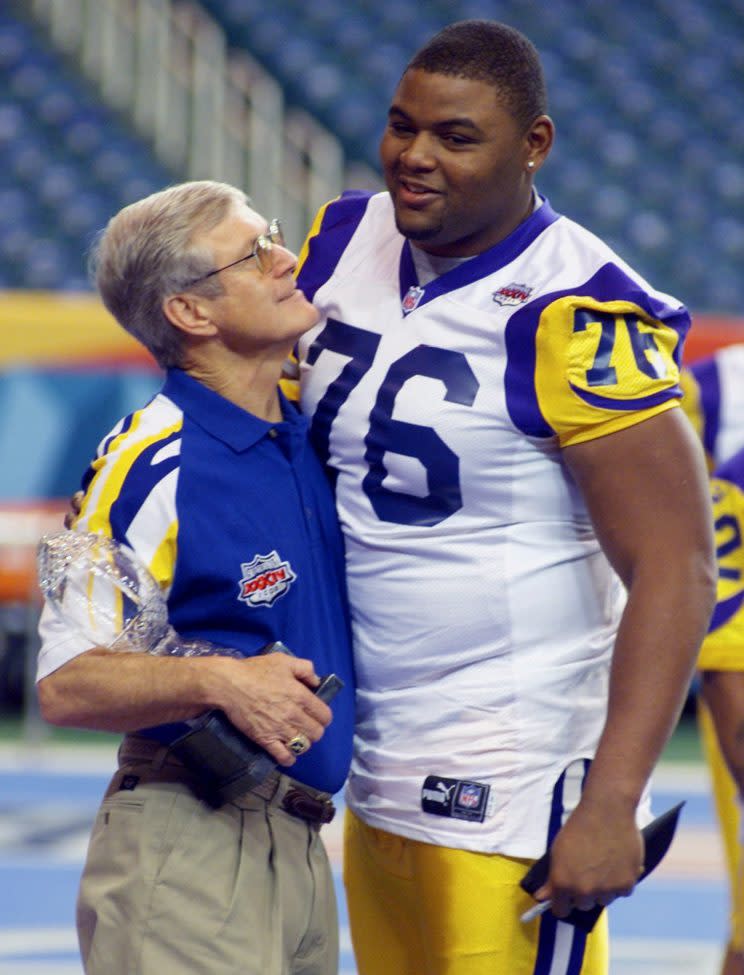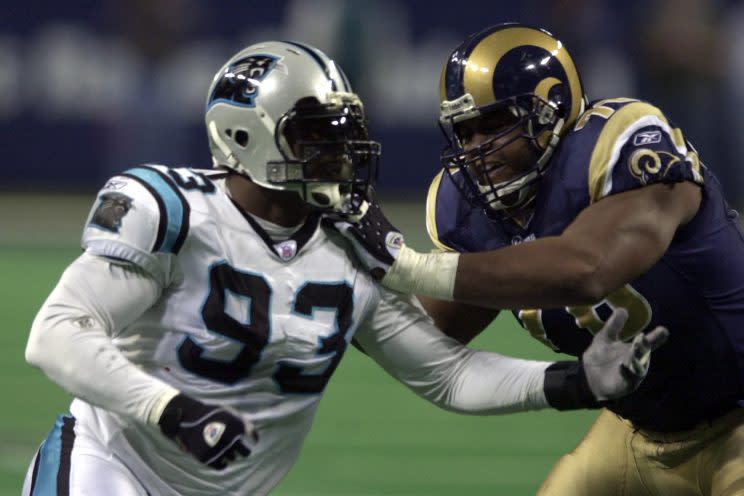Rams put up extremely high bar for Orlando Pace and he met it
The Pro Football Hall of Fame’s Class of 2016 gets inducted on Saturday. Shutdown Corner will profile the eight new Hall of Famers, looking at each of their careers and their impact on the game.
Orlando Pace, offensive tackle
St. Louis Rams, 1997-2008
Chicago Bears, 2009
Greatest moment
Certainly, Pace and the Rams winning Super Bowl XXXIV was the high-water mark for both the player and the franchise. Pace was three years into what would become a dominant career — and the first of his five All-Pro awards and seven Pro Bowl invites — as a cog in the “Greatest Show on Turf” offense that changed the way the NFL viewed the passing game starting in that 1999 season.
Let’s amend that slightly and add one more moment to Pace’s mantel. Two seasons later, he was at the peak of his career when the Rams rebounded from a disappointing 2000 season to put up even more incredible numbers in 2001. They lost two games by a total of 10 points and won 10 games by double digits and made a second Super Bowl in a three-year span.
Pace became a critical factor in the NFC championship game against the Philadelphia Eagles, protecting a banged-up Kurt Warner, who was nursing a rib injury. The game plan was to run the ball more than usual, and Pace led the way for a different style of Rams attack until he was rolled up on by defensive tackle Paul Grasmanis. After missing a little less than a quarter with an MCL sprain, Pace returned to pave the way for two second-half 1-yard TD runs by Marshall Faulk, who rushed for 159 yards on 31 carries — much of it behind Pace.

“People overlook how tough he was,” former Rams offensive coordinator and head coach Mike Martz told Shutdown Corner in July. “But that’s the part that never got overlooked around here.”
The Rams would overpower the Eagles that day, and though they lost the Super Bowl to the New England Patriots, Pace’s dominant performance in that All-Pro season — and his gutsy effort in that NFC title game — should not be overlooked. Martz sincerely worried the following week that Pace coming back into the conference title game might have prevented him from playing in the Super Bowl two weeks later.
“Obviously, he’s as talented as there ever has been at that position,” Martz said. “But his competitiveness, his toughness — that was what put him into that truly special category.”
[Yahoo Fantasy Football is open for the 2016 season. Sign up now]
Impact on the game
It used to be that offensive tackles were considered the safest picks in the NFL draft, and Pace helped establish that. Once he showed his dominance as both a pass and run blocker, other teams saw the impact he had on one of the transcendent offenses in history.
Pace was the No. 1 overall pick in 1997, kicking off perhaps the last dominant era of left tackles in league history. No tackle had been taken first overall before Pace since 1968 (Ron Yary). But in the 10 drafts after Pace and Walter Jones — the first and sixth overall picks, respectively, in 1997 — made their first Pro Bowls in 1999 there were 10 top-six offensive tackles selected. In the 10 drafts prior to Pace and Jones being drafted in 1997, there had been only four O-linemen total to go in the top-six range.
NFL teams sought those impossibly large and athletic men as anchors for their offenses. As it turned out, Pace, Jones and Jonathan Ogden (fourth overall pick, 1996) were three rare specimens who defied logic — and were exceptions to the rule at the position.
“Remember, I had done about five of his games [as an announcer] before we drafted him,” Rams head coach Dick Vermeil told Shutdown Corner, “so I knew how special he was. We drafted him to be great. Really, we drafted him to be a Hall of Famer. The expectations were sky-high the minute he arrived, and they were beyond met.
“He was the best big man athlete I ever coached. Everyone was looking for that type of player, but they were hard to find.”
Case against his bust in Canton
It’s tough to argue Pace wasn’t a Hall of Famer at his peak, which came during the Rams’ heyday from 1999 to 2004. But like the Rams’ run of greatness, Pace’s career — and his dominance — was relatively short.
After becoming a starter in his fifth NFL game, he missed nine starts through Week 3 of the 2006 season. But from that point on in his final three-plus seasons, Pace missed 30 games and finished his career as a shell of himself in a poor season with the Bears.
Of the nine Hall of Fame offensive linemen whose careers overlapped with Pace’s, all nine played more games than he did. In fact, only two offensive tackles from the post-merger era who are in Canton — Rayfield Wright and Dan Dierdorf — played fewer regular-season games than Pace’s 169.
Perhaps you could argue, too, that Pace’s reputation was overinflated by the Rams’ offensive greatness at times, as a member of the NFL’s All-Decade Team of the 2000s, especially in his final years in St. Louis. But there was little questioning his rare ability through most of his first decade in the NFL.

There were few players as talented as Pace, who made plays few others could.
“See that hashmark over there?” Martz asked rhetorically, pointing to the left side of the field around the 45-yard line at the former Edward Jones Dome. “We’re playing Cincinnati [in 2003] and it was some kind of run play. [Pace] took this guy and deposited him over on the [right] sideline all the way across the field. Pancaked the guy and ran him all the way across the field.
“That poor guy didn’t come back in the game. That was my favorite play of his.”
Former Rams tight end Ernie Conwell has another favorite Pace play, one from his rookie season of 1997.
“We ran a screen and Amp Lee was our back in Atlanta,” Conwell said. “Amp’s about 25, 30 yards into [a 57-yard gain], and all of a sudden you see this huge body coming in. Here’s Big O, who is running past him. You’re just thinking, who is this dude? It was insane.”
Former Rams and Seahawks offensive tackle Grant Williams played alongside Jones and Pace each for multiple years and saw firsthand just how special they were.
“Both were incredible,” Williams said. “I couldn’t even say which one was better. They were so much above every other tackle I played with. I knew they were great also because teams would take their best pass rusher, the ones who usually rushed from their side, and moved them over to my side [at right tackle]. They wanted no part of them.
“They had the best feet I had ever seen who were 330 or 340 pounds. It was just incredible to watch them move.”
Pace’s athleticism went beyond the gridiron, too. This author once watched Pace sink 49 of 50 free throws on a Dave & Buster’s basketball rim — one that was smaller than a regulation hoop. Williams jokingly said he hated Pace from the moment he watched him pick up golf and hit bombs off the tee straight down the fairway in his first crack at the sport. Conwell said Pace was probably the best basketball player on those Rams teams.
“Here’s this guy 6-foot-7 and 340 [pounds] who was dribbling between his legs and dunking during a little pickup hoops game we had,” Conwell said. “I never saw anything like it. They pretty much outlawed the hoops games after that.”
– – – – – – –
Eric Edholm is a writer for Shutdown Corner on Yahoo Sports. Have a tip? Email him at edholm@yahoo-inc.com or follow him on Twitter!


